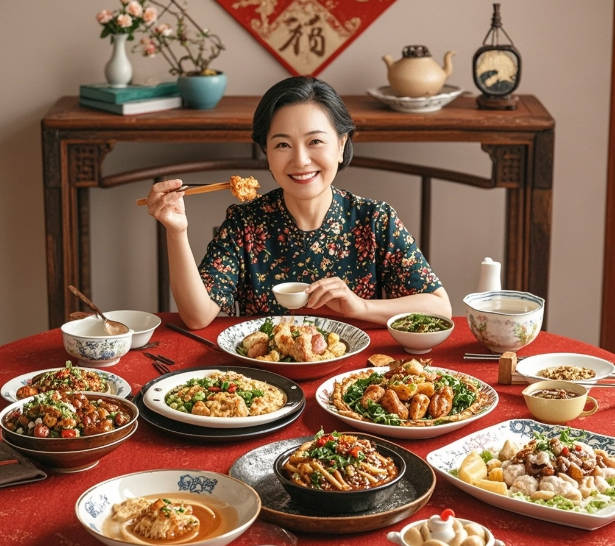Welcome, food enthusiasts and culinary adventurers! Prepare your taste buds for an extraordinary expedition through the diverse and delectable world of Chinese cuisine. China’s vast landscape, rich history, and cultural diversity have given birth to a culinary tradition that’s as varied as it is delicious. In this comprehensive guide, we’ll take you on a mouthwatering tour of China’s regional specialties, diving deep into the flavors, ingredients, and cooking techniques that make each cuisine unique. Get ready to discover the true depth and breadth of Chinese food!
1. Sichuan Chinese Cuisine: The Bold and the Spicy
Sichuan province, located in southwestern China, is renowned worldwide for its fiery, bold flavors and the infamous Sichuan peppercorn, which creates a unique numbing sensation known as “mala”.
Key Dishes:
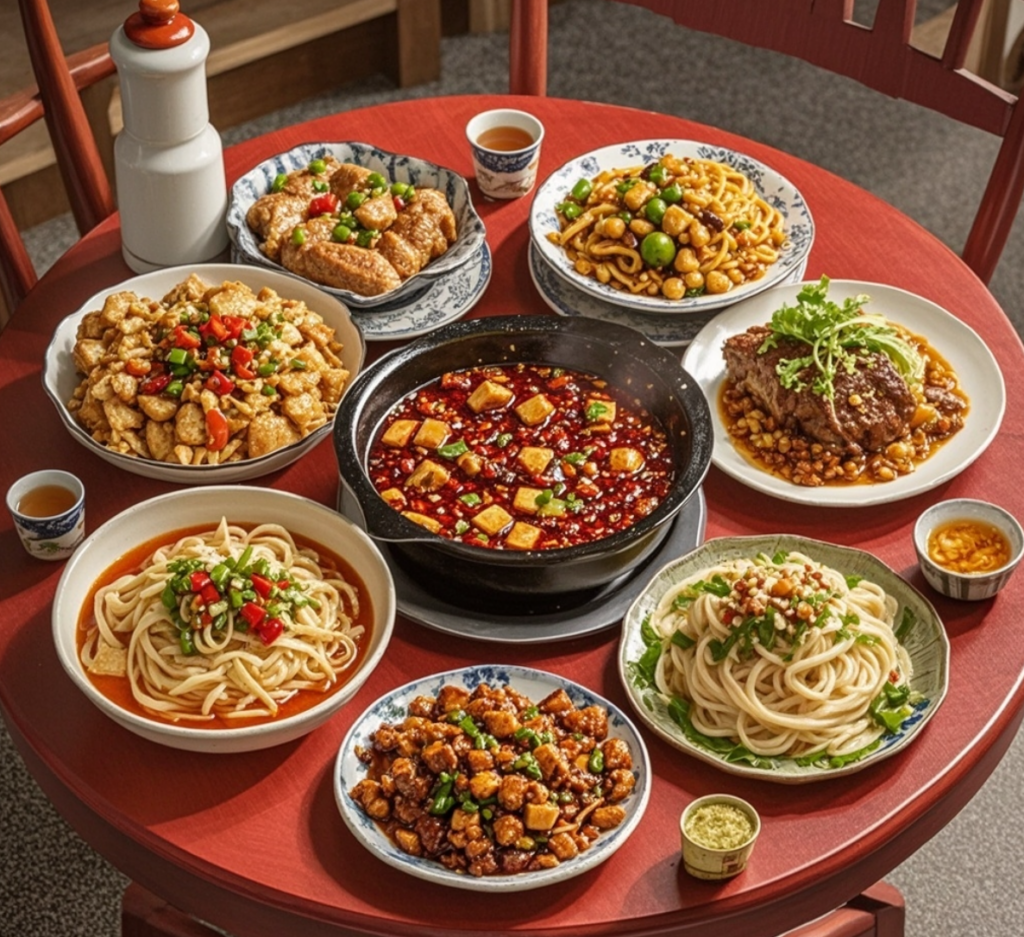
- Mapo Tofu (麻婆豆腐): Soft tofu cubes in a spicy sauce with minced meat (usually pork). The dish perfectly balances the numbing effect of Sichuan peppercorns with the heat of chili oil.
- Kung Pao Chicken (宫保鸡丁): Diced chicken stir-fried with peanuts, vegetables, and dried chili peppers. The sauce is a perfect blend of spicy, sweet, and sour flavors.
- Hot Pot (火锅): A communal dish where diners cook various raw ingredients in a simmering pot of spicy broth at the table. It’s not just a meal, but a social experience.
- Twice-Cooked Pork (回锅肉): Pork belly that’s first boiled, then stir-fried with vegetables and a spicy bean paste.
- Dan Dan Noodles (担担面): Noodles served with a spicy sauce containing preserved vegetables, chili oil, Sichuan peppercorns, minced pork, and scallions.
Flavor Profile:
Sichuan cuisine is characterized by its bold use of garlic, chili peppers, and the unique numbing spiciness of Sichuan peppercorns. The cuisine often combines spicy, salty, sour, and sweet flavors in a single dish.
Cooking Techniques:
Stir-frying, braising, and dry-braising (gan shao) are common. Many dishes start with frying aromatics in oil to release their flavors.
Pro Tips:
- Start with milder dishes and work your way up to spicier ones.
- Try the local Sichuan peppercorn oil for an authentic taste.
- Don’t miss out on trying some of the pickled vegetables that often accompany meals.
2. Cantonese Chinese Cuisine: The Art of Subtle Flavors
Cantonese cuisine, from the Guangdong province in southern China, is perhaps the most widely recognized Chinese cuisine internationally. It’s known for its mild, fresh flavors and emphasis on letting the natural tastes of ingredients shine.
Key Dishes:
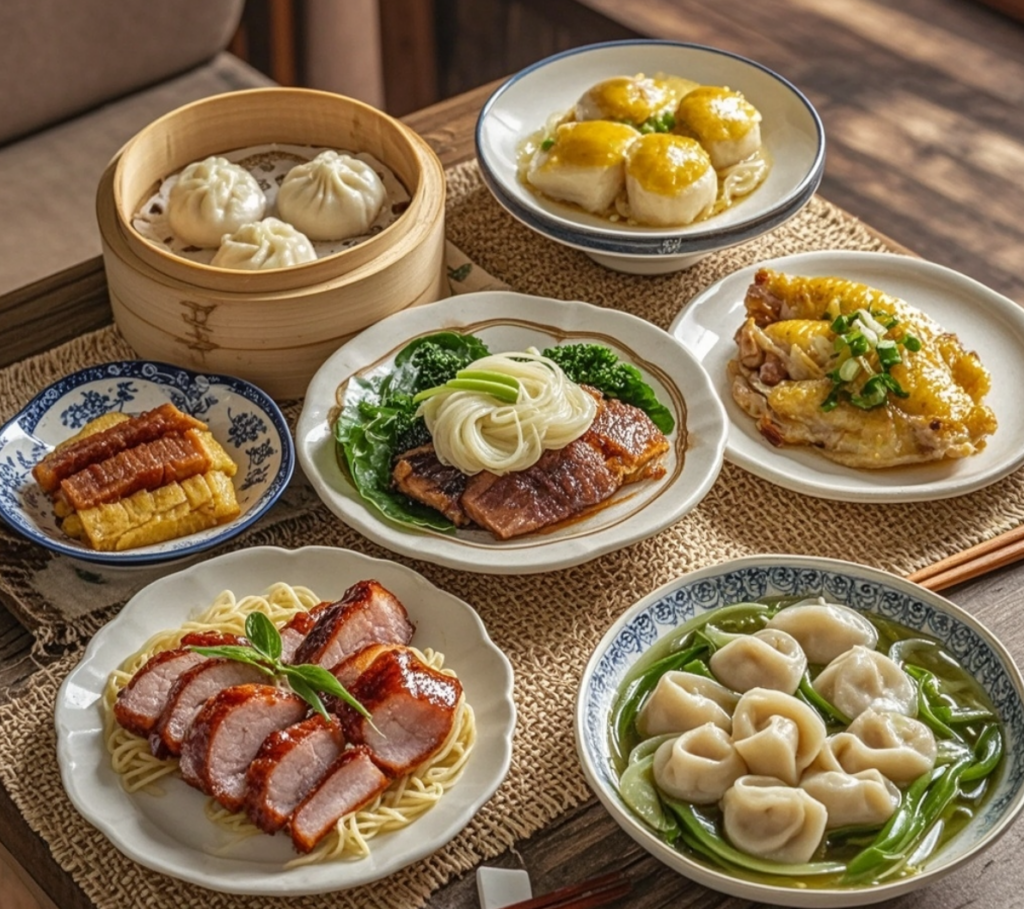
- Dim Sum (点心): A variety of small dishes, often served in steamer baskets. Popular items include har gow (shrimp dumplings), siu mai (pork and shrimp dumplings), and char siu bao (barbecue pork buns).
- Char Siu (叉烧): Barbecued pork with a sweet glaze, often seen hanging in the windows of Cantonese restaurants.
- Steamed Fish: Whole fish delicately seasoned with ginger, scallions, and soy sauce, then steamed to perfection.
- Wonton Noodle Soup (云吞面): A comforting soup featuring delicate pork and shrimp dumplings in a clear broth with egg noodles.
- White Cut Chicken (白切鸡): A simple yet flavorful dish of poached chicken served with a ginger and scallion dipping sauce.
Flavor Profile:
Cantonese cuisine emphasizes the natural flavors of fresh ingredients. Seasonings are used sparingly to enhance rather than mask the food’s original taste. The cuisine is generally light, with a balance of meat and vegetables.
Cooking Techniques:
Steaming and stir-frying are the most common cooking methods, as they help preserve the natural flavors and textures of ingredients. Braising and roasting are also popular, especially for meats.
Pro Tips:
- Try yum cha, the traditional Cantonese brunch featuring dim sum and tea.
- Don’t be afraid to try some of the more unusual ingredients like chicken feet or tripe – they’re local delicacies!
- When ordering fish, “steamed with ginger and scallion” is a classic preparation that showcases Cantonese cooking at its best.
3. Hunan Chinese Cuisine: Smoky, Spicy, and Bold
Hunan cuisine, from the province of the same name in south-central China, is known for its liberal use of chili peppers, shallots, and garlic. It’s often confused with Sichuan cuisine due to its spiciness, but Hunan dishes tend to be purer in their heat, without the numbing effect of Sichuan peppercorns.
Key Dishes:

- Dong’an Chicken (东安子鸡): A tangy, spicy chicken dish flavored with chili peppers, ginger, and vinegar.
- Fish Head with Chopped Chili (剁椒鱼头): A fiery dish featuring a whole fish head smothered in chopped chili peppers.
- Mao’s Braised Pork (毛氏红烧肉): Also known as Hong Shao Rou, this sweet and spicy pork belly dish was reportedly Chairman Mao’s favorite.
- Smoked Pork with Dried Long Beans (干豆角炒腊肉): A homestyle dish that showcases the smoky flavors prevalent in Hunan cuisine.
- Steamed Fish with Salted Chili (豆豉蒸鱼): Fresh fish steamed with fermented black beans and chili, a perfect blend of spicy and savory.
Flavor Profile:
Hunan cuisine is characterized by its heat, which tends to be more straightforward than Sichuan cuisine. Dishes often have a smoky flavor due to the use of smoked and cured ingredients. There’s also a notable sour component in many dishes, achieved through the use of vinegars and pickled ingredients.
Cooking Techniques:
Stir-frying, steaming, and smoking are all common in Hunan cuisine. Many dishes involve a two-step cooking process, such as braising followed by stir-frying.
Pro Tips:
- If you’re sensitive to spice, ask for your dish to be prepared “xiao la” (小辣), which means “mildly spicy”.
- Try some of the local pickled vegetables, which are a staple in Hunan cuisine.
- Don’t miss out on the smoked meats, a specialty of the region.
4. Shandong Chinese Cuisine: Fresh, Sea-Inspired Flavors
Shandong cuisine, from the coastal province in eastern China, is one of the most influential regional cuisines in Chinese culinary history. It’s known for its emphasis on fresh ingredients, seafood, and soups.
Key Dishes:
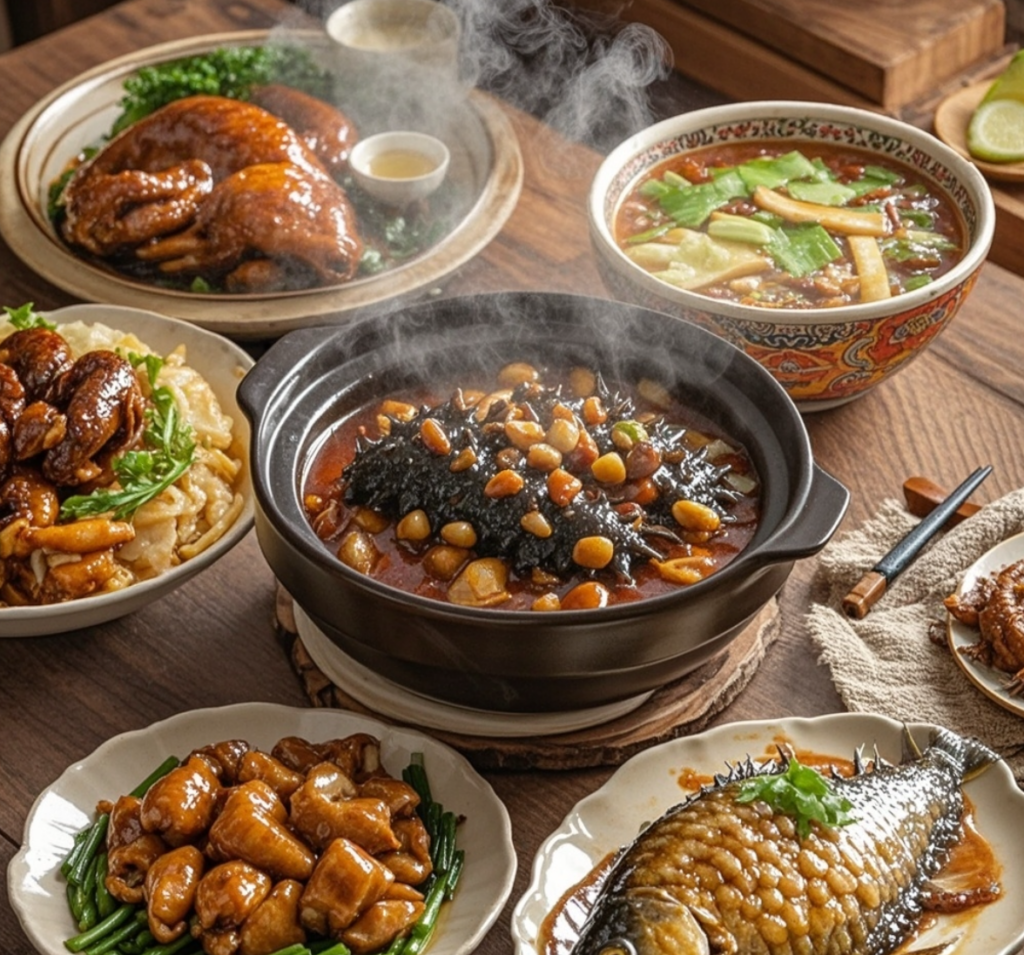
- Braised Sea Cucumber (葱烧海参): A delicacy prized for its unique texture, usually braised with shallots and garlic.
- Sweet and Sour Carp (糖醋鲤鱼): A whole carp deep-fried and served with a tangy sweet and sour sauce.
- Braised Intestines in Brown Sauce (九转大肠): Don’t let the name put you off – this dish of pork intestines braised in a complex, flavorful sauce is a local favorite.
- Dezhou Braised Chicken (德州扒鸡): A whole chicken slow-cooked with spices until the meat is tender and infused with flavor.
- Lü Cuisine Soup (鲁菜汤): A clear, flavorful soup that exemplifies the importance of broths in Shandong cooking.
Flavor Profile:
Shandong cuisine emphasizes the fresh, natural flavors of ingredients, particularly seafood. Dishes tend to be saltier and less oily than those from other regions. Soups and broths play a crucial role in the cuisine.
Cooking Techniques:
Quick stir-frying to seal in flavors, braising, and deep-frying are all common. The cuisine is also known for its complex soup-making techniques.
Pro Tips:
- Try the local Laoshan mineral water, famous throughout China for its purity.
- Don’t miss out on the seafood dishes, especially if you’re visiting coastal cities like Qingdao.
- Be adventurous with organ meats – dishes like the braised intestines are local specialties.
5. Jiangsu Chinese Cuisine: Elegant and Artistic
Jiangsu cuisine, from the eastern coastal province, is known for its elegant presentation, meticulous preparation methods, and subtle, light flavors. It’s often considered one of the most refined Chinese cuisines.
Key Dishes:
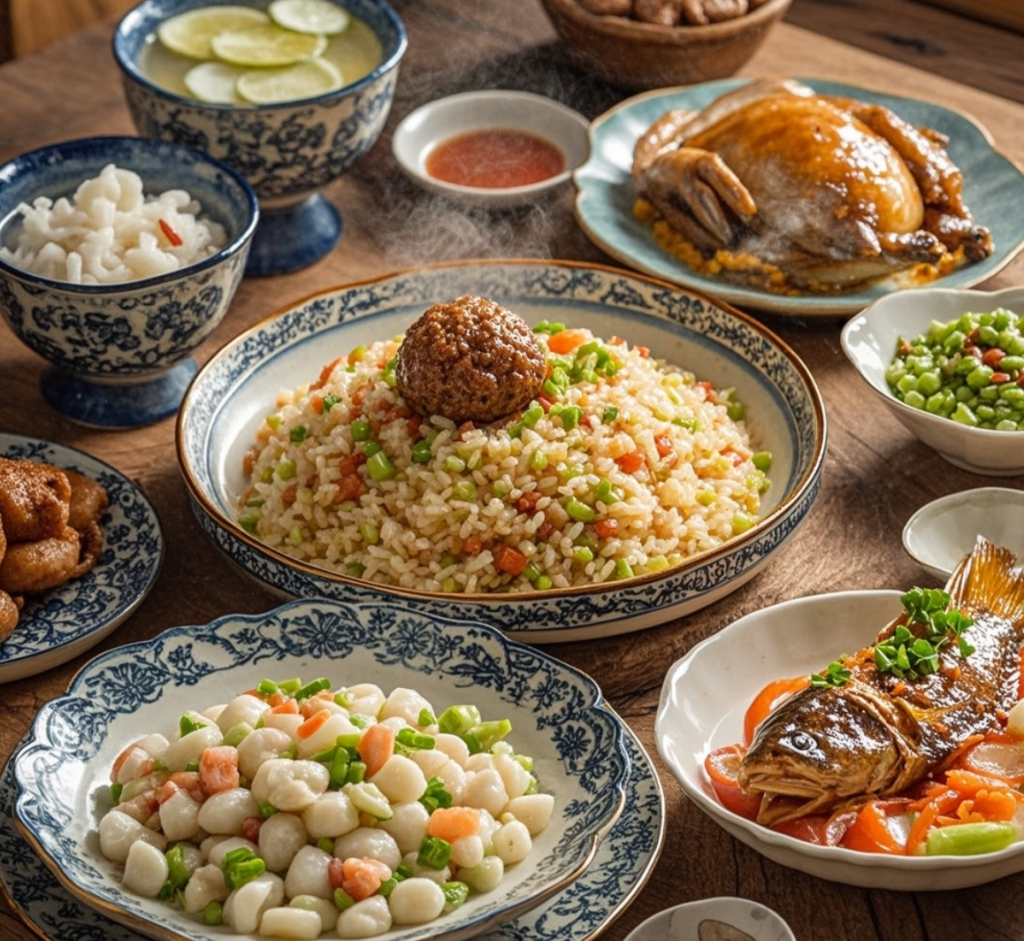
- Yangzhou Fried Rice (扬州炒饭): A colorful fried rice dish with a variety of ingredients, including shrimp, pork, and vegetables.
- Lion’s Head Meatballs (狮子头): Large, tender pork meatballs stewed in a savory broth, often served with vegetables.
- Squirrel-Shaped Mandarin Fish (松鼠桂鱼): A visually stunning dish where a whole fish is deep-fried and served with a sweet and sour sauce, made to resemble a squirrel.
- Nanjing Salted Duck (南京盐水鸭): A famous cold dish of duck marinated in brine and spices.
- Jade Shrimp (翡翠虾仁): Shrimp stir-fried with green vegetables to create a dish that resembles green jade.
Flavor Profile:
Jiangsu cuisine is characterized by its light, fresh, and mildly sweet flavors. The cuisine emphasizes the natural taste of ingredients and is less oily than many other Chinese cuisines.
Cooking Techniques:
Braising, stewing, and quick-frying are common. The cuisine is known for its precise cooking times and temperatures to achieve the perfect texture.
Pro Tips:
- Pay attention to the presentation – Jiangsu chefs often create visually stunning dishes.
- Try some of the region’s famous teas, like Biluochun green tea.
- Don’t miss out on trying the local “hairy crabs” if you visit in autumn.
6. Zhejiang Chinese Cuisine: Light, Fresh, and Seasonal
Zhejiang cuisine, from the eastern coastal province, is known for its light, fresh flavors, mellow fragrance, and tender textures. It emphasizes the use of seasonal ingredients and seafood.
Key Dishes:

- Dongpo Pork (东坡肉): Named after the famous poet Su Dongpo, this is a melt-in-your-mouth braised pork belly dish.
- Longjing Shrimp (龙井虾仁): River shrimp quickly stir-fried with local Longjing green tea leaves.
- Beggar’s Chicken (叫化鸡): A whole chicken wrapped in lotus leaves and clay, then baked. The clay is cracked open at the table for a dramatic presentation.
- West Lake Fish in Vinegar Gravy (西湖醋鱼): Fresh fish served in a tangy, slightly sweet vinegar sauce.
- Hangzhou-style Duck (杭州酱鸭): Duck marinated in a soy-based sauce and spices, then steamed and served cold.
Flavor Profile:
Zhejiang cuisine is notable for its light, fresh, and mildly sweet flavors. It’s less oily than many other Chinese cuisines and emphasizes the natural flavors of ingredients, particularly seafood.
Cooking Techniques:
Quick-frying, stir-frying, braising, and steaming are common. The cuisine is known for its knife skills, with ingredients often cut into intricate shapes.
Pro Tips:
- Visit Hangzhou’s West Lake to try some of the region’s most famous dishes in their place of origin.
- Don’t miss out on trying some local Shaoxing wine, a type of rice wine famous throughout China.
- If you visit in spring, try some dishes featuring bamboo shoots, a local seasonal delicacy.
7. Fujian Chinese Cuisine: Umami-Rich Seafood Delights
Fujian cuisine, from the southeastern coastal province, is known for its use of unique ingredients, seafood, and soup-making techniques. It’s characterized by its light but flavorful tastes and emphasis on umami.
Key Dishes:
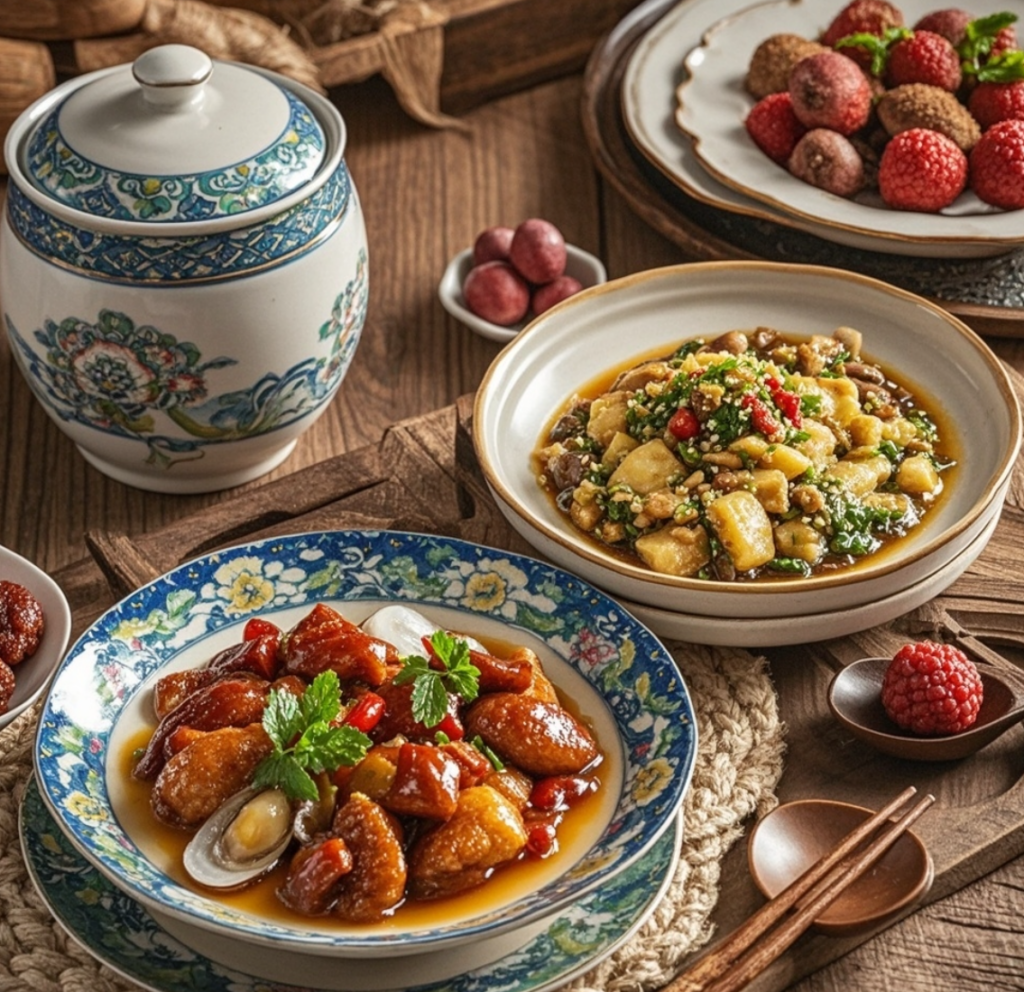
- Buddha Jumps Over the Wall (佛跳墙): A luxurious soup with premium ingredients like abalone, shark fin, sea cucumber, and bird’s nest. (Note: Some restaurants offer versions without controversial ingredients like shark fin.)
- Oyster Omelet (海蛎煎): A popular street food featuring fresh oysters in a savory egg batter, often served with a sweet-and-sour sauce.
- Red Wine Chicken (福建红糟鸡): Chicken cooked in red rice wine, giving it a distinctive color and flavor.
- Lychee Pork (荔枝肉): Despite the name, this dish doesn’t contain lychees. It’s pork cut to resemble lychee fruit, then fried and coated in a sweet and sour sauce.
- Wuyi Mountain Taro (武夷山芋): A simple but delicious dish of taro braised in a savory broth.
Flavor Profile:
Fujian cuisine is known for its light, umami-rich flavors. It often combines sweet and sour tastes and makes extensive use of seafood and soups.
Cooking Techniques:
Braising, stewing, steaming, and quick-frying are all common. The cuisine is also famous for its “red cooking” technique, which involves braising in red rice wine.
Pro Tips:
- Try some Fujian-style soups – the region is famous for its soup-making techniques.
- Don’t miss out on the local seafood, especially if you’re visiting coastal cities.
- If you’re adventurous, try some dishes featuring unique local ingredients like sea worm.
8. Xinjiang Chinese Cuisine: A Taste of Central Asia
Xinjiang cuisine, from China’s far western region, shows strong Middle Eastern and Central Asian influences. It’s distinctly different from other Chinese cuisines, featuring lots of lamb, wheat-based staples, and dairy products.
Key Dishes:

- Lamb Kebabs (羊肉串): Spiced lamb skewers grilled to perfection, a popular street food throughout China.
- Big Plate Chicken (大盘鸡): A hearty dish of chicken, potatoes, and bell peppers in a spicy sauce, typically served over hand-pulled noodles.
- Nang Bread (馕): A type of flatbread baked in a tandoor-like oven, often sold by street vendors.
- Laghman (拉条子): Hand-pulled noodles served with a sauce of meat and vegetables.
- Yogurt (酸奶): Xinjiang-style yogurt is thicker and tangier than what you might be used to, often served with a sprinkle of sugar.
Flavor Profile:
Xinjiang cuisine is characterized by its use of cumin, red pepper, and other spices. It’s generally bold and rich in flavors. The combination of lamb and various seasonings creates a unique taste that is both savory and slightly spicy. Dairy products add a creamy and tangy element to many dishes.
Cooking Techniques:
Grilling, roasting, and stir-frying are common cooking methods. The high heat and direct cooking ensure that the meats are tender and flavorful, while the use of large pots and pans allows for generous portions of ingredients to be cooked together.
Pro Tips:
- When trying lamb kebabs, look for places that use fresh lamb and a balanced blend of spices.
- Don’t forget to pair your meal with a cup of traditional Xinjiang tea.
- If you have the opportunity, visit a local market to taste a variety of freshly made dairy products.
9. Anhui Chinese Cuisine: Rich and Savory
Key Dishes:
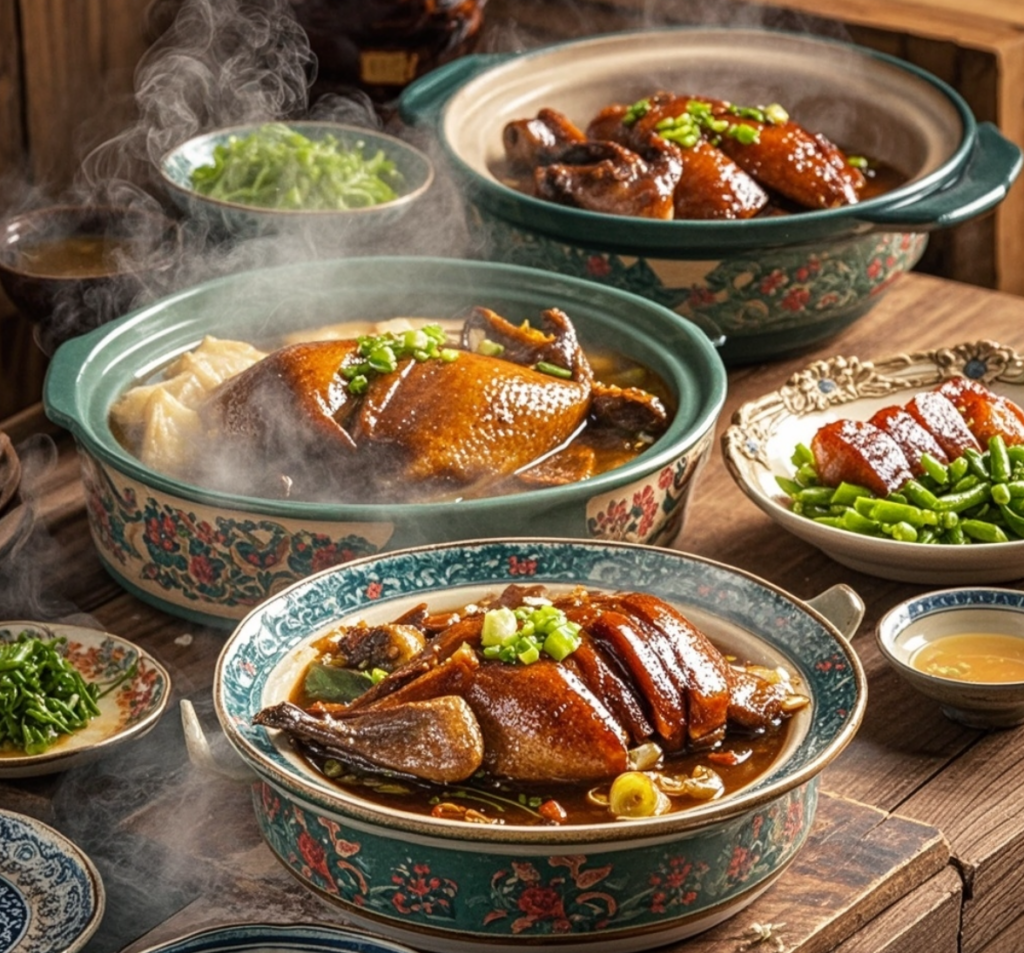
- Hui Style Braised Pigeon (徽州卤鸽): Pigeons braised in a flavorful sauce until tender and juicy.
- Stinky Mandarin Fish (臭鳜鱼): A unique dish with a strong odor but delicious taste, thanks to special fermentation techniques.
- Huangshan Stewed Chicken (黄山炖鸡): Chicken cooked slowly with local herbs and spices.
- Anhui Braised Pork (安徽红烧肉): Succulent pork braised to perfection with a rich sauce.
Flavor Profile:
Anhui cuisine combines savory, sweet, and spicy flavors. The use of local ingredients and traditional cooking methods creates a distinct taste.
Cooking Techniques:
Stewing, braising, and smoking are common techniques employed in Anhui cuisine.
Pro Tips:
- Try the local bamboo shoot dishes when in season.
- Don’t be put off by the smell of the stinky mandarin fish – it’s a delicacy worth trying.
10.Henan Chinese Cuisine: Hearty and Traditional
Key Dishes:
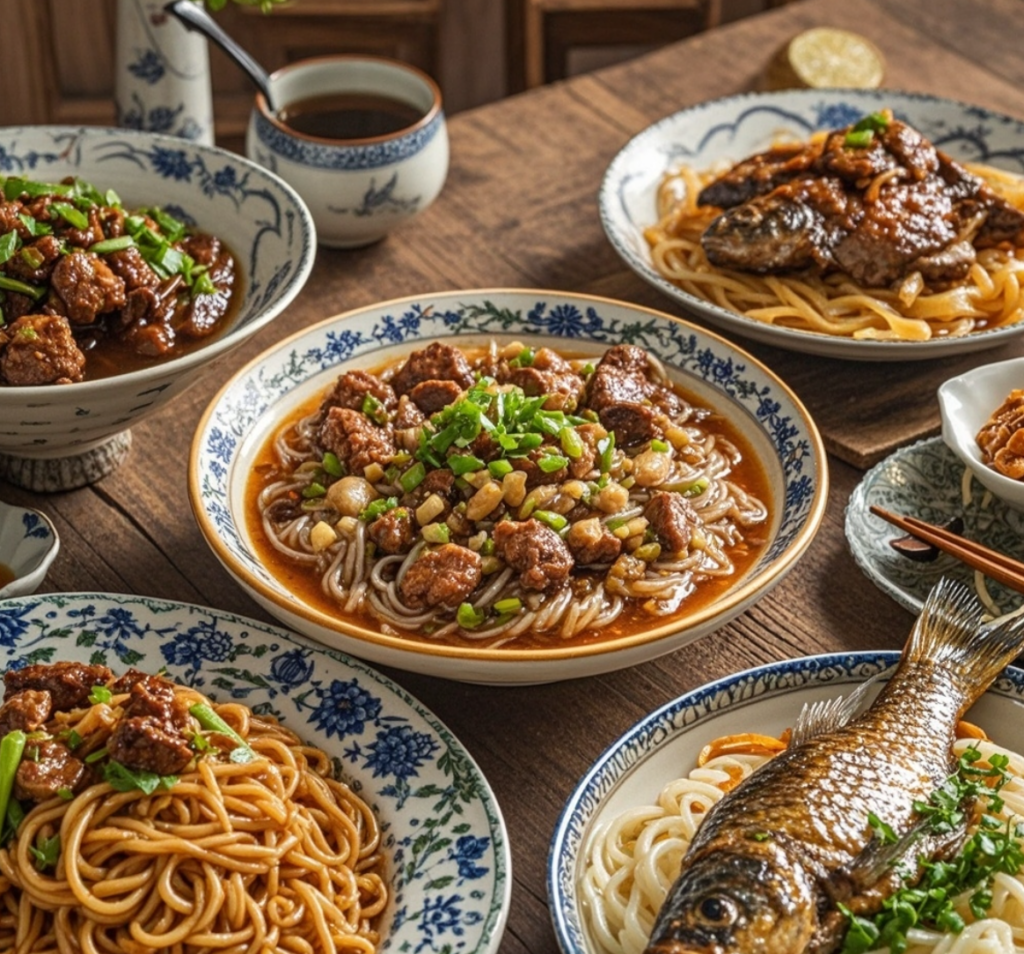
- Braised Pork with Vermicelli (猪肉炖粉条): A comforting dish with tender pork and chewy vermicelli.
- Sautéed Henan Noodles (河南炒面): Noodles stir-fried with vegetables and seasonings.
- Stewed Henan Duck (河南炖鸭): A flavorful duck dish cooked with local spices.
- Braised Carp in Henan Style (河南红烧鲤鱼): Fresh carp braised to a delicious finish.
Flavor Profile:
The flavors are robust and often feature bold seasonings. The cuisine emphasizes balanced tastes and substantial ingredients.
Cooking Techniques:
Braising, frying, and stewing are frequently used to bring out the best in the ingredients.
Pro Tips:
- Sample the local wheat-based dishes to experience the essence of Henan cuisine.
- Pair your meal with a local brew for an authentic experience.
11.Hubei Chinese Cuisine: Spicy and Varied
Key Dishes:
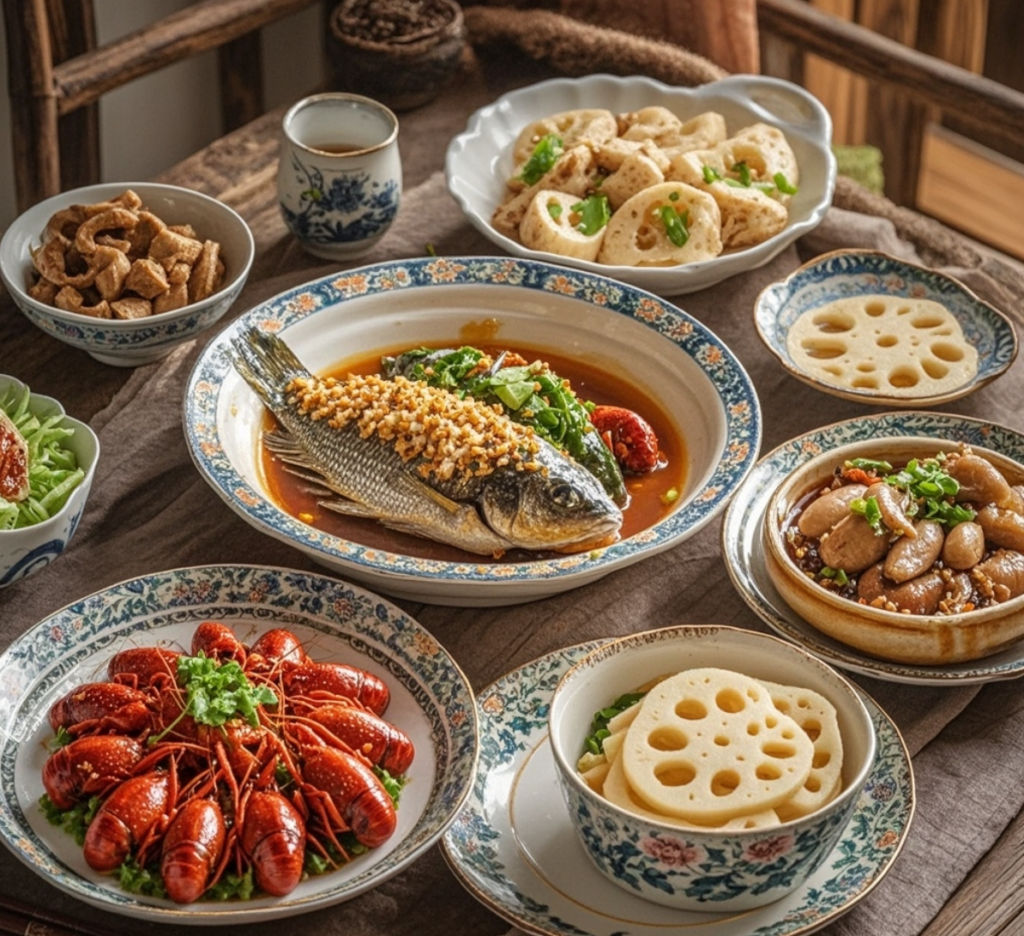
- Three Steamed Delicacies (沔阳三蒸): Consisting of steamed meat, fish, and vegetables.
- Wuchang Fish (武昌鱼): A famous freshwater fish dish prepared in various styles.
- Spicy Shrimp (麻辣小龙虾): Popular especially during the summer months.
- Braised Duck with Lotus Root (莲藕炖鸭): A combination of tender duck and crispy lotus root.
Flavor Profile:
Hubei cuisine is known for its spiciness and the use of diverse seasonings. There is a balance of flavors with both hot and savory notes.
Cooking Techniques:
Steaming, stir-frying, and braising are common methods that highlight the freshness of the ingredients.
Pro Tips:
- Try the local fish dishes to enjoy the fresh produce from the region’s waters.
- Be adventurous and sample the different spicy levels available in the dishes.
12.Guangxi Chinese Cuisine: Flavors of the South
Key Dishes:
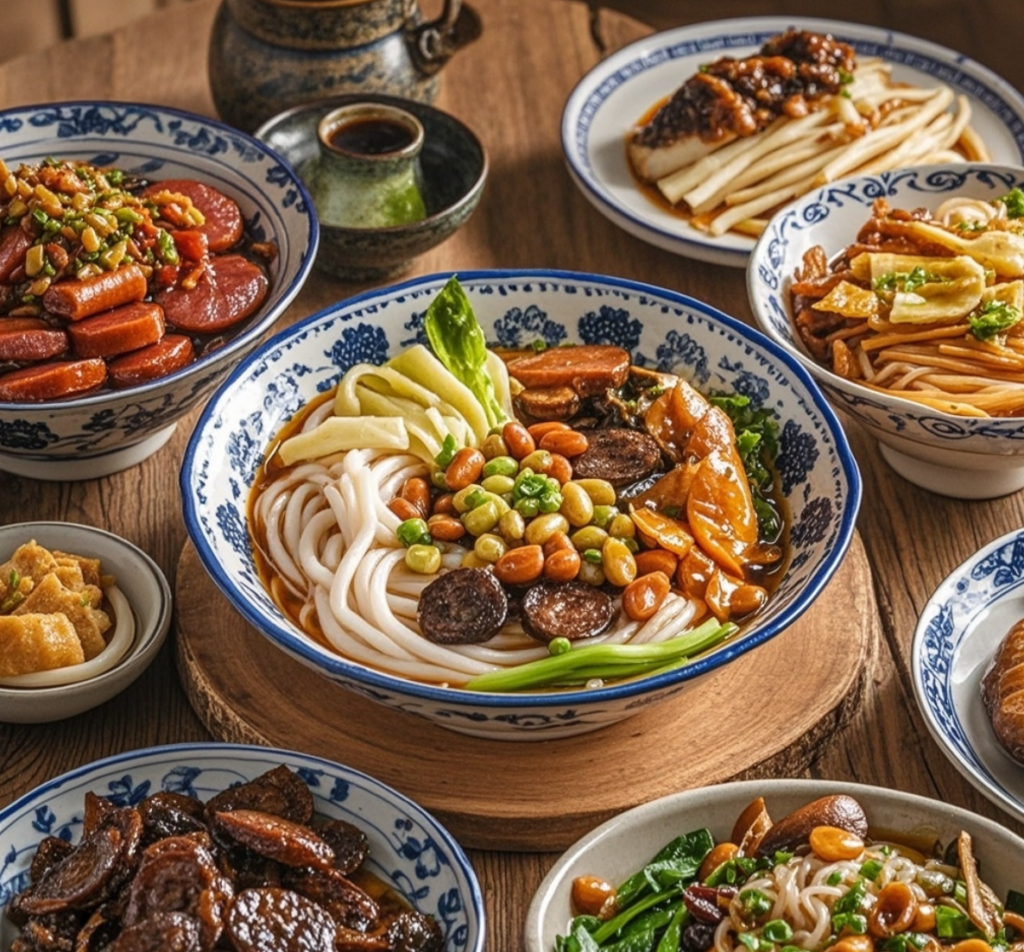
- Guilin Rice Noodles (桂林米粉): A staple dish with a flavorful broth and various toppings.
- Liuzhou Luosifen (柳州螺蛳粉): Known for its pungent and spicy aroma.
- Bamboo Shoot and Sausage (笋干腊肠): A combination of local bamboo shoots and flavorful sausages.
- Braised Snakehead Fish (红烧黑鱼): A tender fish dish.
Flavor Profile:
The cuisine features a mix of sour, spicy, and sweet flavors. It incorporates a variety of local herbs and spices.
Cooking Techniques:
Quick-frying, stewing, and steaming are commonly employed to preserve the flavors and textures.
Pro Tips:
- Explore the local street food markets to discover hidden culinary gems.
- Try the various types of rice noodles available in Guangxi.
Conclusion of Chinese Cuisine
Chinese cuisine is a vast and vibrant tapestry of flavors, techniques, and traditions. Each region offers a unique culinary adventure that reflects the local culture, history, and ingredients. We hope this exploration has sparked your appetite and inspired you to embark on your own culinary journey through the diverse and delicious world of Chinese regional cuisines. Bon appétit!
FAQs of Chinese Cuisine
1.How do I know which regional cuisine is best for me if I have specific dietary restrictions?
Consider your restrictions and look at the key ingredients and cooking methods of each cuisine. For example, if you’re avoiding spicy foods, Cantonese or Jiangsu cuisines might be better options.
2.Can I recreate these regional dishes at home?
Yes, with the right ingredients and following accurate recipes, you can attempt to recreate many of these dishes. Online tutorials and cookbooks can be helpful.
3.Which region is famous for its seafood dishes?
Shandong cuisine from the coastal province in eastern China is known for its emphasis on fresh ingredients, seafood, and soups. Dishes like Braised Sea Cucumber, Sweet and Sour Carp, and Dezhou Braised Chicken are popular. Jiangsu and Zhejiang cuisines from the eastern coastal provinces also emphasize seafood.
4.Are there any unique soups in Chinese regional cuisines?
Fujian cuisine is famous for its soup-making techniques. Dishes like Buddha Jumps Over the Wall are luxurious soups. Shandong cuisine also has a strong tradition of making flavorful soups like Lü Cuisine Soup.
5.What are some pro tips for trying Xinjiang cuisine?
When trying Xinjiang cuisine, look for places that use fresh lamb and a balanced blend of spices for lamb kebabs. Don’t forget to pair your meal with a cup of traditional Xinjiang tea. If possible, visit a local market to taste a variety of freshly made dairy products.
Related with Chinese Cuisine
2.144-hour-Visa-Free Transit policies for Foreign Nationals – A Complete Guide in 2024

